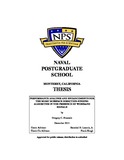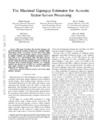Fast high-resolution techniques applied to the Direction of Arrival (DOA) of signals problem
| dc.contributor.advisor | Fargues, Monique P. | |
| dc.contributor.advisor | Hippenstiel, Ralph | |
| dc.contributor.author | Ferreira Filho, Milton Pinto | |
| dc.date | September 1992 | |
| dc.date.accessioned | 2012-11-29T16:14:34Z | |
| dc.date.available | 2012-11-29T16:14:34Z | |
| dc.date.issued | 1992-09 | |
| dc.identifier.uri | https://hdl.handle.net/10945/23673 | |
| dc.description.abstract | Subspace decomposition methods are a very useful technique to extract the signal information via Eigen-based estimators. Although these techniques are very accurate, they are usually expensive to update, becoming difficult to implement for real-life applications. The Rank-Revealing QR (RRQR) factorization introduced by Chan, offers an attractive alternative to perform the subspace selection. In this work, we use the RRQR algorithm applied to the Direction of Arrival (DOA) problem to track moving sources, using passive linear arrays. In addition to the regular RRQR algorithm originally proposed by Chan, this thesis introduces an improvement. This refinement uses the signal subspace information and requires very little additional computation. It takes advantage of the Hermitian property of the signal correlation matrix and is implicitly equivalent to applying one subspace iteration step to the estimated signal subspace. Simulations show that the performance obtained is equivalent to that obtained using classical Eigen-based techniques. Alternative algorithms for finding an approximation of the smallest singular vector of the correlation matrix are discussed and compared to the original method. The final product is an adaptive algorithm that allows for tracking of DOA angles when moving sources are present. An analysis of the number of flops needed to execute the adaptive algorithm based on the RRQR factorization to track the DOA of moving sources has been included, showing its feasibility for being used in real-time implementations. | en_US |
| dc.description.uri | http://archive.org/details/fasthighresoluti1094523673 | |
| dc.format.extent | 100 p. | en_US |
| dc.language.iso | en_US | |
| dc.publisher | Monterey, California. Naval Postgraduate School | en_US |
| dc.rights | Copyright is reserved by the copyright owner | en_US |
| dc.title | Fast high-resolution techniques applied to the Direction of Arrival (DOA) of signals problem | en_US |
| dc.type | Thesis | en_US |
| dc.contributor.corporate | Naval Postgraduate School | |
| dc.contributor.department | Department of Electrical and Computer Engineering | |
| dc.subject.author | High-resolution | en_US |
| dc.subject.author | Minimum norm | en_US |
| dc.subject.author | Direction of Arrival | en_US |
| dc.subject.author | Angle of Arrival | en_US |
| dc.subject.author | Eigenstructure | en_US |
| dc.subject.author | Autocorrelation matrix | en_US |
| dc.subject.author | Correlation matrix | en_US |
| dc.subject.author | Tracking | en_US |
| dc.subject.author | Moving sources | en_US |
| dc.description.service | Lieutenant Commander, Brazilian Navy | en_US |
| etd.thesisdegree.name | M.S. in Electrical Engineering | en_US |
| etd.thesisdegree.level | Masters | en_US |
| etd.thesisdegree.discipline | Electrical Engineering | en_US |
| etd.thesisdegree.grantor | Naval Postgraduate School | en_US |
| dc.description.distributionstatement | Approved for public release; distribution is unlimited. |
Files in this item
This item appears in the following Collection(s)
-
1. Thesis and Dissertation Collection, all items
Publicly releasable NPS Theses, Dissertations, MBA Professional Reports, Joint Applied Projects, Systems Engineering Project Reports and other NPS degree-earning written works.





